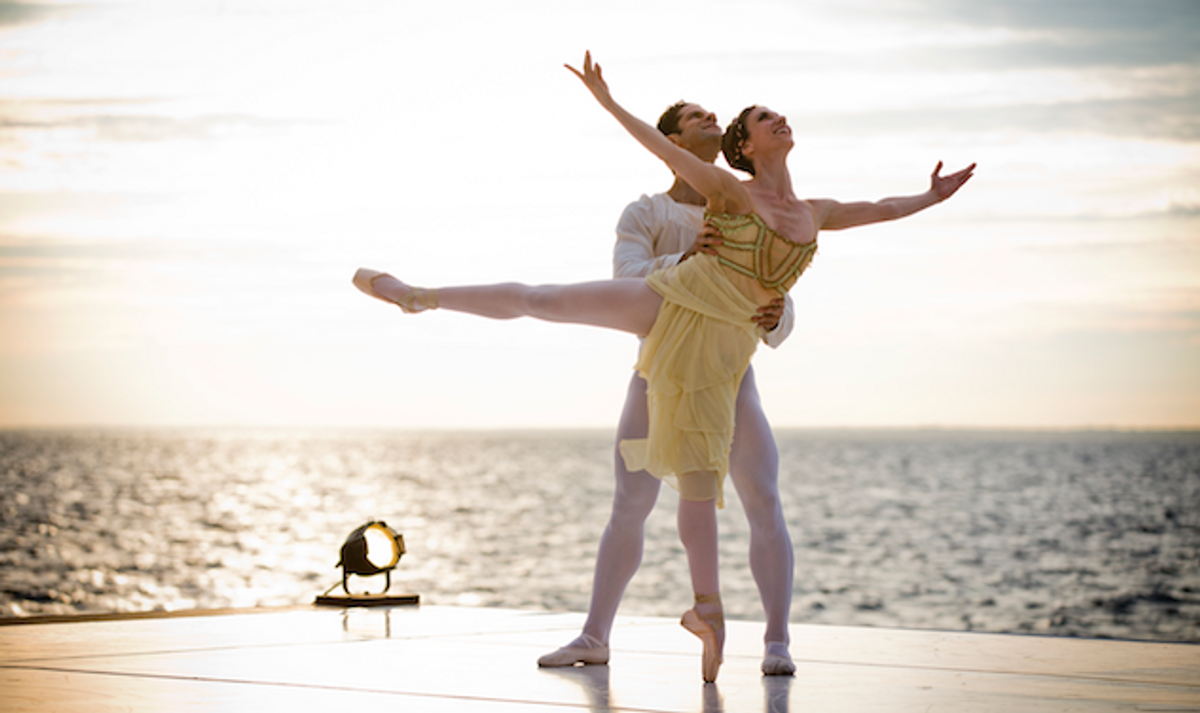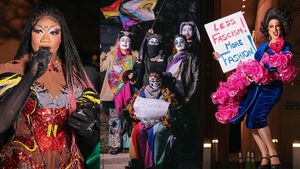Marcelo Gomes and Luciana Paris | Photography by Whitney Browne
In 1994, Denise Roberts Hurlin and fellow members of the Paul Taylor Dance Company flew to New Mexico to visit Jeff Wadlington, a dancer with the company, who was dying of AIDS. They arrived just before midnight; he died three hours later. Jeff was 29.
The following year, Roberts Hurlin and Hernando Cortez, also a Taylor dancer, held the first Fire Island Dance Festival on a makeshift stage with about 60 audience members to raise funds for Dancers Responding to AIDS, the organization they started in 1991 (and which became part of the Broadway Cares/Equity Fights AIDS umbrella in 1993). The scrappy show, where Roberts Hurlin poured cocktails and seven dancers performed in the rain, raised just shy of $8,000. This year, the event shattered fundraising records by raising $533,860, according to the organization.
This past weekend, the Fire Island Dance Festival celebrated its 20th anniversary. It has turned into quite an operation, and quite a fun tasting menu of dance. The festival now boasts three performances held at a swanky private residence on the bay. Temporary stadium seating, erected over a covered pool, seats 400-plus guests per performance, who enjoy an open bar before the show. In front of you is a simple and spectacular scene: An infinity stage drops off into dark water with the blue-green iridescence of a black pearl.
On the stage, a staircase leads to a balcony that leads to nowhere, the show's only set piece, provided for the opening duet from Romeo and Juliet. I'm sure the American Ballet Theater dancers Marcelo Gomes and Luciana Paris would have looked just as lovely indoors, but only lifted against an open sky does one truly understand Juliet as the "winged messenger of heaven" that Shakespeare described.
Though it was born with the mission to combat AIDS and planted roots in the sand of the country's most famous gay refuge, the Fire Island Dance Festival doesn't necessarily cater to those themes in its programming. Still, this weekend, there were several works that explicitly nodded to issues relevant to the gay community.
SLIDESHOW | PHOTOS OF THE 20th ANNIVERSARY PERFORMANCES
Nick Kenkel's Good in Goodbye was a tribute to his college roommate who passed away from AIDS; the late Arte Phillips' Adam, Eve & Steve was a tender, sculptural threesome for two men and one woman; Igual, choreographed by Gomes (it means "equal" in his native Portuguese) was commissioned by the festival, and was performed by four members of Complexions Contemporary Ballet. It takes inspiration from the marriage equality movement, whose astonishing progress was echoed in Ian Ng's propulsive original score.
Joshua Bergasse, choreographer of the TV show Smash (R.I.P.), unleashed the New York City Ballet force known as Sara Mearns into a sea of eight men-in-black in a Roxie Hart-like number that's all legs and sultry stares - basically one big wink. (And as with anything attractive that winks at you, you can't help smiling.)
 An unexpected highlight came Patrick Makuakane's San Francisco-based contemporary hula company Na Lei Hulu I Ka Wekiu, which presented a male trio that paid tribute to the navigator and astronomer Maui. Ryan Fuimaono, Jason Ogao and Makuakane, heads and waists wrapped in spikey wreaths, were powerful, sensual and hypnotizing in their communion with nature. So too, was Jon Eden in Momix's Man Fan, a solo that elegantly juxtaposes human struggle with billowing grace. Eden manipulates and negotiates a towering white, nylon fan splayed like peacock feathers at least ten feet overhead, fighting and succumbing to the wind to near spiritual effect. There was perhaps no better metaphor to the achievement of the festival itself, which has turned nature's sometimes-devastating temper into a thing of beauty.
An unexpected highlight came Patrick Makuakane's San Francisco-based contemporary hula company Na Lei Hulu I Ka Wekiu, which presented a male trio that paid tribute to the navigator and astronomer Maui. Ryan Fuimaono, Jason Ogao and Makuakane, heads and waists wrapped in spikey wreaths, were powerful, sensual and hypnotizing in their communion with nature. So too, was Jon Eden in Momix's Man Fan, a solo that elegantly juxtaposes human struggle with billowing grace. Eden manipulates and negotiates a towering white, nylon fan splayed like peacock feathers at least ten feet overhead, fighting and succumbing to the wind to near spiritual effect. There was perhaps no better metaphor to the achievement of the festival itself, which has turned nature's sometimes-devastating temper into a thing of beauty.
In the middle of the performances, Roberts Hurlin and Broadway Cares executive director Tom Viola took to the stage to announce that his year, for the first time, the festival passed the $500,000 fundraising mark, bringing its cumulative total to nearly $4 million since its inception in support of a variety of services for performing artists and those living with HIV/AIDS across the country.
They evoked the spirit of Wadlington and Christopher Gillis, another Taylor dancer lost to AIDS, both of whom are "still dancing with us," said Viola. They both choked up. It had been a cloudy day since the beginning. Earlier in the afternoon, during tech rehearsals, a few pesky drops of water fell, like a spinning lawn sprinkler passing overhead. But by the time the performances began, the clouds were fleeing and the sky began to blush. The festival that began nearly 20 years ago in the rain got the sunlight it deserved.
More Information About Dancers Responding to AIDS.


































 An unexpected highlight came Patrick Makuakane's San Francisco-based contemporary hula company Na Lei Hulu I Ka Wekiu, which presented a male trio that paid tribute to the navigator and astronomer Maui. Ryan Fuimaono, Jason Ogao and Makuakane, heads and waists wrapped in spikey wreaths, were powerful, sensual and hypnotizing in their communion with nature. So too, was Jon Eden in Momix's Man Fan, a solo that elegantly juxtaposes human struggle with billowing grace. Eden manipulates and negotiates a towering white, nylon fan splayed like peacock feathers at least ten feet overhead, fighting and succumbing to the wind to near spiritual effect. There was perhaps no better metaphor to the achievement of the festival itself, which has turned nature's sometimes-devastating temper into a thing of beauty.
An unexpected highlight came Patrick Makuakane's San Francisco-based contemporary hula company Na Lei Hulu I Ka Wekiu, which presented a male trio that paid tribute to the navigator and astronomer Maui. Ryan Fuimaono, Jason Ogao and Makuakane, heads and waists wrapped in spikey wreaths, were powerful, sensual and hypnotizing in their communion with nature. So too, was Jon Eden in Momix's Man Fan, a solo that elegantly juxtaposes human struggle with billowing grace. Eden manipulates and negotiates a towering white, nylon fan splayed like peacock feathers at least ten feet overhead, fighting and succumbing to the wind to near spiritual effect. There was perhaps no better metaphor to the achievement of the festival itself, which has turned nature's sometimes-devastating temper into a thing of beauty.






















































